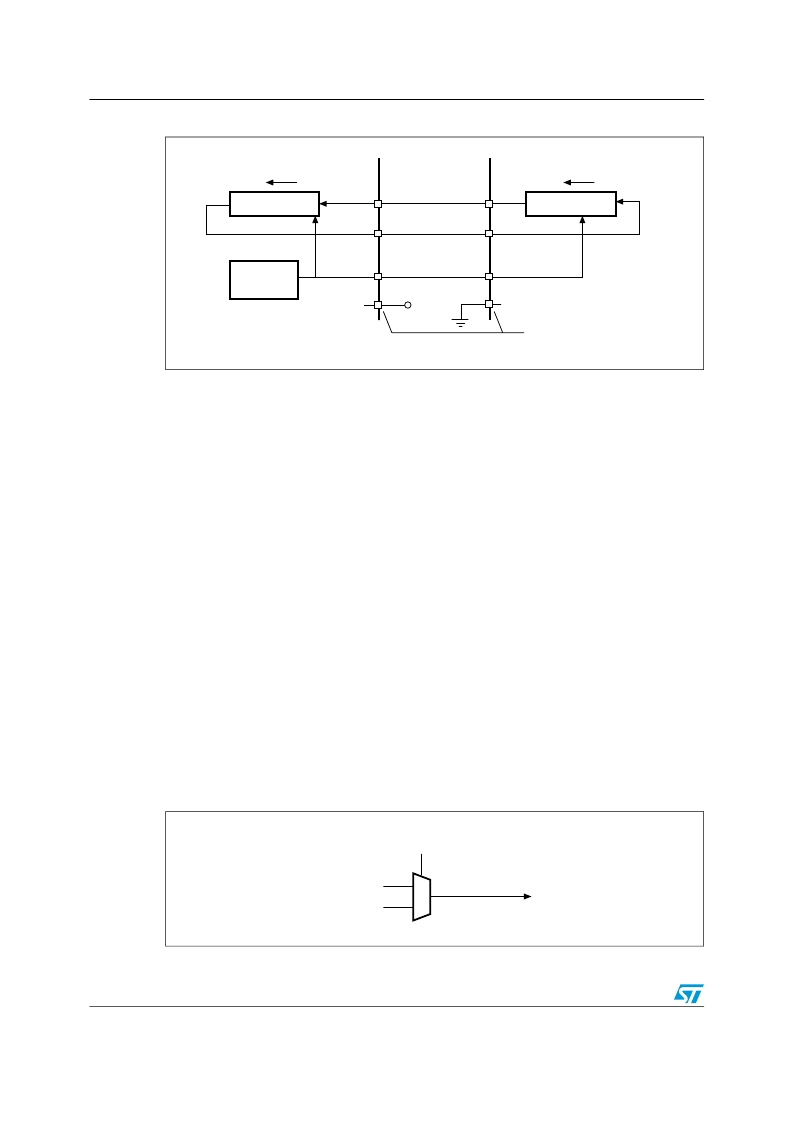- 您现在的位置:买卖IC网 > Sheet目录342 > MCBSTM32EXL (Keil)BOARD EVALUATION FOR STM32F103ZE
�� �
�
 �
�Serial� peripheral� interface� (SPI)�
�Figure� 208.� Single� master/� single� slave� application�
�Master�
�Slave�
�RM0008�
�MSBit�
�LSBit�
�MSBit�
�LSBit�
�8-bit� shift� register�
�SPI� clock�
�MISO�
�MOSI�
�SCK�
�MISO�
�MOSI�
�SCK�
�8-bit� shift� register�
�generator�
�NSS� (1)�
�V� DD�
�NSS� (1)�
�Not� used� if� NSS� is� managed�
�by� software�
�ai14745�
�1.� Here,� the� NSS� pin� is� configured� as� an� input.�
�The� MOSI� pins� are� connected� together� and� the� MISO� pins� are� connected� together.� In� this�
�way� data� is� transferred� serially� between� master� and� slave� (most� significant� bit� first).�
�The� communication� is� always� initiated� by� the� master.� When� the� master� device� transmits�
�data� to� a� slave� device� via� the� MOSI� pin,� the� slave� device� responds� via� the� MISO� pin.� This�
�implies� full-duplex� communication� with� both� data� out� and� data� in� synchronized� with� the�
�same� clock� signal� (which� is� provided� by� the� master� device� via� the� SCK� pin).�
�Slave� select� (NSS)� pin� management�
�There� are� two� NSS� modes:�
�●�
�●�
�Software� NSS� mode:� this� mode� is� enabled� by� setting� the� SSM� bit� in� the� SPI_CR1�
�register� (see� Figure� 209� ).� In� this� mode,� the� external� NSS� pin� is� free� for� other�
�application� uses� and� the� internal� NSS� signal� level� is� driven� by� writing� to� the� SSI� bit� in�
�the� SPI_CR1� register.�
�Hardware� NSS� mode:� there� are� two� cases:�
�–�
�–�
�NSS� output� is� enabled:� when� the� STM32F20xxx� is� operating� as� a� Master� and� the�
�NSS� output� is� enabled� through� the� SSOE� bit� in� the� SPI_CR2� register,� the� NSS� pin�
�is� driven� low� and� all� the� NSS� pins� of� devices� connected� to� the� Master� NSS� pin� see�
�a� low� level� and� become� slaves� when� they� are� configured� in� NSS� hardware� mode.�
�When� an� SPI� wants� to� broadcast� a� message,� it� has� to� pull� NSS� low� to� inform� all�
�others� that� there� is� now� a� master� for� the� bus.� If� it� fails� to� pull� NSS� low,� this� means�
�that� there� is� another� master� communicating,� and� a� Hard� Fault� error� occurs.�
�NSS� output� is� disabled:� the� multimaster� capability� is� allowed.�
�Figure� 209.� Hardware/software� slave� select� management�
�SSM� bit�
�SSI� bit�
�NSS� external� pin�
�1�
�0�
�NSS� Internal�
�ai14746�
�590/995�
�Doc� ID� 13902� Rev� 9�
�发布紧急采购,3分钟左右您将得到回复。
相关PDF资料
MCBTMPM330
BOARD EVAL TOSHIBA TMPM330 SER
MCIMX25WPDKJ
KIT DEVELOPMENT WINCE IMX25
MCIMX53-START-R
KIT DEVELOPMENT I.MX53
MCM69C432TQ20
IC CAM 1MB 50MHZ 100LQFP
MCP1401T-E/OT
IC MOSFET DRVR INV 500MA SOT23-5
MCP1403T-E/MF
IC MOSFET DRIVER 4.5A DUAL 8DFN
MCP1406-E/SN
IC MOSFET DVR 6A 8SOIC
MCP14628T-E/MF
IC MOSFET DVR 2A SYNC BUCK 8-DFN
相关代理商/技术参数
MCBSTM32EXLU
功能描述:开发板和工具包 - ARM EVAL BOARD + ULINK2 FOR STM32F103ZG
RoHS:否 制造商:Arduino 产品:Development Boards 工具用于评估:ATSAM3X8EA-AU 核心:ARM Cortex M3 接口类型:DAC, ICSP, JTAG, UART, USB 工作电源电压:3.3 V
MCBSTM32EXLU-ED
制造商:ARM Ltd 功能描述:KEIL STM STM32EXL EVAL BOARD
MCBSTM32EXLUME
功能描述:开发板和工具包 - ARM EVAL BOARD + ULINKME FOR STM32F103ZG
RoHS:否 制造商:Arduino 产品:Development Boards 工具用于评估:ATSAM3X8EA-AU 核心:ARM Cortex M3 接口类型:DAC, ICSP, JTAG, UART, USB 工作电源电压:3.3 V
MCBSTM32F200
功能描述:开发板和工具包 - ARM EVAL BOARD FOR STM STM32F207IG
RoHS:否 制造商:Arduino 产品:Development Boards 工具用于评估:ATSAM3X8EA-AU 核心:ARM Cortex M3 接口类型:DAC, ICSP, JTAG, UART, USB 工作电源电压:3.3 V
MCBSTM32F200U
功能描述:开发板和工具包 - ARM EVAL BOARD FOR STM STM32F207IG + ULINK2
RoHS:否 制造商:Arduino 产品:Development Boards 工具用于评估:ATSAM3X8EA-AU 核心:ARM Cortex M3 接口类型:DAC, ICSP, JTAG, UART, USB 工作电源电压:3.3 V
MCBSTM32F200UME
功能描述:开发板和工具包 - ARM EVAL BOARD FOR STM STM32F207IG ULINK-ME
RoHS:否 制造商:Arduino 产品:Development Boards 工具用于评估:ATSAM3X8EA-AU 核心:ARM Cortex M3 接口类型:DAC, ICSP, JTAG, UART, USB 工作电源电压:3.3 V
MCBSTM32F200UME-ED
制造商:ARM Ltd 功能描述:KEIL STM32F207IG EVAL BOARD
MCBSTM32F400
功能描述:开发板和工具包 - ARM EVAL BOARD FOR STM STM32F407IG
RoHS:否 制造商:Arduino 产品:Development Boards 工具用于评估:ATSAM3X8EA-AU 核心:ARM Cortex M3 接口类型:DAC, ICSP, JTAG, UART, USB 工作电源电压:3.3 V